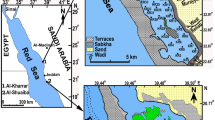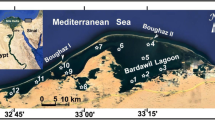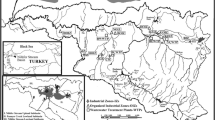Abstract
The composition (% relative abundance) of diatom assemblages from soft bottom sediments was studied at 75 sites situated in 46 rivers, brooks, and ditches in the islands of Hiiumaa and Saaremaa and in the lowland of West Estonia. Although the total number of recorded taxa was 205, the studied diatom assemblages consisted of 54, 55, 48, and 50 constant species in the drainage basin of Moonsund, the Gulf of Riga, Hiiumaa, and Saaremaa, respectively. The habitats of the dominating taxa were heterogenous and the most widespread species were Achnanthidium minutissimum, Martyana martyi, Meridion circulare, Cocconeis placentula, Planothidium lanceolatum, and Amphora pediculus. The Shannon–Weaver diversity (H′) index varied from 2.09 to 4.63. Multivariate analyses were used to identify the environmental variables governing the composition and structure of the benthic diatom assemblage. Principal Component Analysis (PCA) and Redundancy Analysis (RDA), based on 56 most abundant taxa, indicated differences in the composition and structure of diatom assemblages between different drainage basins as well as between the upper and lower stream courses. In the headwaters there prevailed small epipsammic diatoms (Martyana, Planothidium, Staurosira, Staurosirella). Different motile epipelic species from the genera Amphora, Navicula, Nitzschia, etc. were distributed abundantly in the lower courses of the streams. There was a positive correlation between order of the stream site and trophic level of water (R=0.35; p<0.05). Along a river system, the increasing order of the stream was accompanied by higher trophic level of water.
Similar content being viewed by others
References
Alles, E., M. Nörpel–Schempp & H. Lange–Bertalot, 1991. Zur Systematic und Ökologie chakteristischer Eunotia–Arten (Bacillariophyceae) in elektrolytarmen Bachoberläufen. Nova Hedwigia 53: 171–213.
Brown, D. H., C. E. Gibby & M. Hickman, 1972. Photosynthetic rhythms in epipelic algal populations. Br. Phycol. J. 7: 37–44.
Chessman, B. C., 1986. Diatom flora of an Australian river system: spatial patterns and environmental relationships. Freshwat. Biol. 16: 805–819.
Descy, J. P., 1979. A new approach to water quality estimation using diatoms. Nova Hedwigia Beih. 64: 305–323.
EJOKN, 1986. Eesti NSV jõgede, ojade ja kraavide ametlik nimestik. Valgus, Tallinn: 72 pp.
Forsberg, C. & S. O. Ryding, 1980. Eutrophication parameters and trophic status indices in 30 Swedish waste–receiving lakes. Arch. Hydrobiol. 89: 189–207.
Gómez, N., 1998. Use of epipelic diatoms for evaluation of water quality in the Matanza–Riachuelo (Argentina), a Pampean plain river. Wat. Res. 32: 2029–2034.
Gómez, N., 1999. Epipelic diatoms from the Matanza–Riachuelo river (Argentina), a highly polluted basin from the pampean plain: biotic indices and multivariate analysis. Aquatic Ecosystem Helth & Management 2: 301–309.
Gordon, N. D., T. A. McMahon & B. L. Fintayson, 1994. Stream Hydrology. An Introduction for Ecologists. John Wiley & Sons. Chichester, New York, Brisbane, Toronto, Singapure: 526 pp.
Grasshoff, K., M. Ehrhardt & K. Kremling (eds), 1983. Methods of Seawater Analyses, 2. Verlag Chemie, Weinheim: 419 pp.
Hang, T & A. Loopmann, 1995. Jõed. In Raukas, A. (ed.), Eesti Loodus. Valgus, Tallinn: 292–302.
Hustedt, F., 1930–1966. Die Kieselalgen Deutschlands, Österreichs und der Schweiz unter Berücksichtigung der übrigen Länder Europas sowie der angrenzenden Meeresgebiete. Teil 1–3. Dr. L. Rabenhorsts Kryptogamen–Flora. 7/1: 920 pp., 7/2: 845 pp., 7/3: 816 pp.
Jeffrey, S. W. & G. F. Humphrey, 1975. New spectrophotometric equations for determing chlorophyll a, b, c1 and c2 in higher plants, algae and natural phytoplankton. Biochem. Physiol. Planzen (BPP): 167 pp.
Järvekülg, A., 1993. Trophy of the water of Estonian rivers and nutrient limiting the primary production. Water pollution and quality in Estonia. Environmental Report 7: 29–34.
Järvekülg, A., 2001. Eesti Jõed. Tartu Ülikooli Kirjastus, Tartu: 750 pp.
Kawecka, B., 1971. Zonal distribution of algal communities in streams of the Polish High Tatra Mountains. Acta Hydrobiol. 13: 393–414.
Kelly, M. G., A. Cazaubon, E. Coring, A. Dell’Uomo, L. Ector, B. Goldsmith, H. Guasch, J. Hürlimann, A. Jarlman, B. Kawecka, J. Kwandrans, R. Laugaste, E.–A. Lindstrøm, M. Leitao, P. Marvan, J. Padisák, E. Pipp, J. Prygiel, E. Rott, S. Sabater, H. van Dam & J. Vizinet, 1998. Recommendations for the routine sampling of diatoms for water quality assessments in Europe. J. appl. Phycol. 10: 215–224.
Krammer, K. & H. Lange–Bertalot, 1986–1991. Bacillariophycea. Süßwasserflora von Mitteleuropa. VEB Gustav Fischer Verlag, Jena: 1986, 2/1: 876 pp.; 1988, 2/2: 596 pp.; 1991, 2/3: 575 pp.; 1991, 2/4: 437 pp.
Lorenzen, G. J., 1967. Determination of chlorophyll and pheopigments: spectrophotometric equations. Limnol. Oceanogr. 12: 343–346.
Loopmann, A., 1979. Eesti NSV jõgede nimestik. Valgus, Tallinn: 157 pp.
Manly, B. F. J., 1997. Distance matrices and spatial data. In: Randomization, Bootstrap and Monte Carlo Methods in Biology, Chapman and Hall, London: 172–204.
Margalef, R., 1960. Ideas for a synthetic approach to the ecology of running waters. Int. Rev. ges. Hydrobiol. 45: 133–153.
Peterson, C. G. & N. C. Tuchman, 1992. Substratum–associated microbiota. Water Environ. Res. 64: 625–632.
Potapova, M., 1996. Epilithic algal communities in rivers of Kolyma Mountains, NE Siberia, Russia. Nova Hedwigia 63: 309–334.
Piirsoo, K., 2001. Phytoplankton of Estonian rivers in midsummer. Hydrobiologia 444: 135–146.
Round, F. E., 1965. The epipsammon; a relatively unknown freshwater algal association. Br. Phycol. Bull. 2: 456–462.
Round, F. E., R. M. Crawford & D. G. Mann, 1990. The Diatoms. Biology and morphology of the genera. Cambridge University Press, Cambridge: 747 pp.
Snoeijs, P. (ed.), 1993. Intercalibration and Distribution of Diatom Species in the Baltic Sea. Opulus Press, Uppsala 1: 129 pp.
Snoeijs, P. & N. Balashova (eds), 1998. Intercalibration and Distribution of Diatom Species in the Baltic Sea. Opulus Press, Uppsala 5: 144 pp.
Snoeijs, P. & J. Kasperovičiené (eds), 1996. Intercalibration and Distribution of Diatom Species in the Baltic Sea. Opulus Press Uppsala 4: 126 pp.
Snoeijs, P. & M. Potapova (eds), 1995. Intercalibration and Distribution of Diatom Species in the Baltic Sea. Opulus Press, Uppsala 3: 126 pp.
Snoeijs, P. & S. Vilbaste (eds), 1994. Intercalibration and Distribution of Diatom Species in the Baltic Sea. Opulus Press, Uppsala 2: 125 pp.
Stevenson, R. J. & S. Hashim, 1989. Variation in diatom community structure among habitats in sandy streams. J. Phycol. 25: 678–686.
Strickland, J. D. H. & T. R. A. Parsons, 1960. A manual of seawater analysis. Bull. Fish. Res, Board Can. 125: 185 pp.
ter Braak, C. J. F., 1990. Update notes: CANOCO version 3.1. Agricultural Mathematics Group, Wageningen: 95 pp.
ter Braak, C. J. F., 1994. Canonical community ordination. Part 1. Basic theory and linear methods. Ecoscience 1: 127–140.
ter Braak, C. J. F. & P. F. M. Verdonschot, 1995. Canonical correspondence analysis and related multivariate methods in aquatic ecology. Aquat. Sci. 57: 255–289.
Thiolouse, J., D. Chessel, S. Doledes & J.–M. Olivier, 1997. ADE–4: a multivariate analysis and graphical display software. Statistics and Computing 7: 75–83.
Viiding, H., 1995. Pealiskord ja selle ehitus. In Raukas, A. (ed.), Eesti Loodus. Valgus, Tallinn: 46–61.
Vilbaste, S., 2000. Ränivetikad–kõige mitmekesisem vetikarühm Eesti jõgedes. In Frey, T. (ed.), Kaasaegse Ökoloogia Probleemid: Loodusteaduslikud Ülevaated Eesti Maa Päeval. Tartu 8: 295–300.
Vilbaste, S., 2001. Benthic diatom communities in Estonian rivers. Boreal Environ. Res. 6: 191–203.
Vilbaste, S., 2001a. Jõgede mikrofütobentos. Klorofüll ja feopigmendid põhjasetteis. In Järvekülg, A. (ed.), Eesti Jõed. Tartu Ülikooli Kirjastus, Tartu: 141–145.
Vilbaste S., K. Sundbäck, C. Nilsson & J. Truu, 2000. Distribution of benthic diatoms in the littoral zone of the Gulf of Riga, the Baltic Sea. Eur. J. Phycol. 35: 373–384.
Author information
Authors and Affiliations
Rights and permissions
About this article
Cite this article
Vilbaste, S., Truu, J. Distribution of benthic diatoms in relation to environmental variables in lowland streams. Hydrobiologia 493, 81–93 (2003). https://doi.org/10.1023/A:1025401716441
Issue Date:
DOI: https://doi.org/10.1023/A:1025401716441




